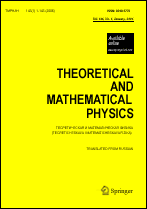|
|
Teoreticheskaya i Matematicheskaya Fizika, 1982, Volume 50, Number 1, Pages 3–76
(Mi tmf2090)
|
|
|
 |
This article is cited in 11 scientific papers (total in 11 papers)
New theory of space-time and gravitation
V. I. Denisov, A. A. Logunov
Abstract:
A field theory of gravitation with minimal coupling is constructed. The gravitational field is described by a symmetric tensor field of second rank in pseudo-Euclidean space-time. The theory is based on the requirement that conservation laws exist for the gravitational field and the matter taken together, this requirement being combined with the geometrization principle.
The field theory of gravitation has the same post-Newtonian parameters as the general theory of relativity, so that these two theories are indistinguishable from the point of view of all post-Newtonian experiments. However, the descriptions of effects in strong gravitational fields and also the properties of gravitational waves differ strongly in the two theories. For example,
in the field theory of gravitation there is no gravitational red shift of the frequency, beam deflection, or time delay associated with the propagation of gravitational waves in external fields. These differences have made it possible to propose a number of gravitational-wave experiments to test the predictions of general relativity and the field theory. A model of the Universe in the field theory of gravitation makes it possible to describe the cosmological frequency red shift. The evolution of this model is determined by the deceleration parameter $q_0$: for $q_0\leqslant 4-\frac32\alpha$, the Universe will expand for ever, whereas for $q_0>4-\dfrac32\alpha$ the “expansion” will be replaced
after a time by “contraction”, and the Universe will return to a singular state.
Received: 19.05.1981
Citation:
V. I. Denisov, A. A. Logunov, “New theory of space-time and gravitation”, TMF, 50:1 (1982), 3–76; Theoret. and Math. Phys., 50:1 (1982), 1–48
Linking options:
https://www.mathnet.ru/eng/tmf2090 https://www.mathnet.ru/eng/tmf/v50/i1/p3
|


|




 Contact us:
Contact us: Terms of Use
Terms of Use
 Registration to the website
Registration to the website Logotypes
Logotypes







 Citation in format
Citation in format 
